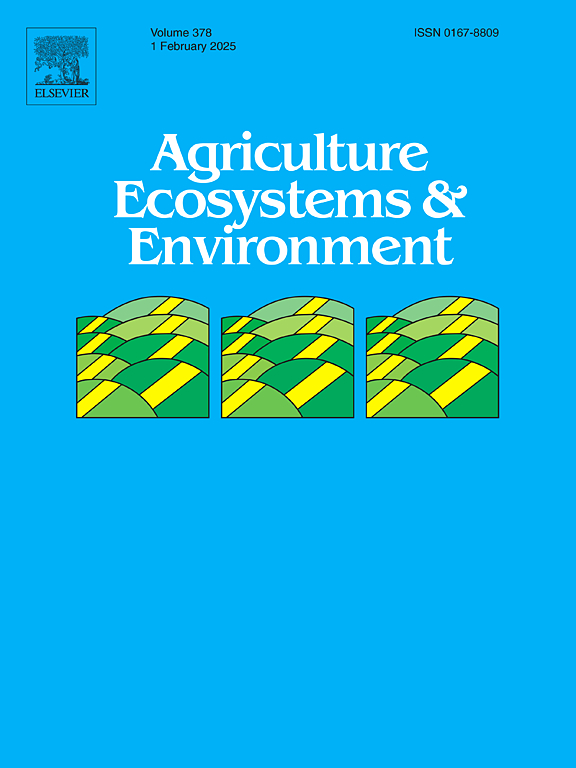Long-term land use conversion influence on soil pore structure and organic carbon
IF 6
1区 农林科学
Q1 AGRICULTURE, MULTIDISCIPLINARY
引用次数: 0
Abstract
Pore structure plays a crucial role in soil carbon (C) dynamics, influencing physical, biological, and chemical processes that govern C protection or decomposition, yet its impact on C losses and gains during land use changes is not fully understood. We investigated the pore structure using X-ray computed tomography (CT) and characterized soil organic C (SOC) and its chemistry using a “space-for-time” substitution approach across four land use: an uncut deciduous forest, a never-tilled grassland, an early successional community restoring native vegetation on historically cultivated soil, and a conventionally intensively managed agricultural system. Soil of intensive agriculture displayed lower porosity (10–12 %), lower volume of pores in the 30–150 μm range (10–20 %), and reduced SOC content (42–75 %) as compared to those in undisturbed forest and grassland. While restoration of the early successional plant community led to a substantial recovery of the pore structure, with pore characteristics approaching those of undisturbed land uses, its SOC-related measures, including particulate and mineral associated organic C, and microbial biomass C, constituted only ∼50 % of the undisturbed grassland and forest benchmarks. Analysis of functional group chemistry demonstrated that SOC gained in agricultural soil upon establishment of early successional community differs in its chemical composition from that lost during past agricultural land use. By integrating pore structure measurements via CT, C fractionation, and microbial activity data, this study highlights the intricate interplay between soil structure and C dynamics, exploring the influence of the pore structure on ecosystem C processing and storage capacity.
长期土地利用转换对土壤孔隙结构和有机碳的影响
孔隙结构在土壤碳(C)动态中起着至关重要的作用,影响着控制碳保护或分解的物理、生物和化学过程,但其对土地利用变化中碳损失和收益的影响尚不完全清楚。我们使用x射线计算机断层扫描(CT)研究了孔隙结构,并使用“空间-时间”替代方法表征了四种土地利用方式下的土壤有机碳(SOC)及其化学特征:未砍伐的落叶林、未开垦的草地、在历史耕作土壤上恢复原生植被的早期演替群落,以及传统集约化管理的农业系统。集约农业土壤孔隙率(10-12 %)较低,30-150 μm范围内孔隙体积(10-20 %)较低,有机碳含量(42-75 %)较未受干扰的森林和草地土壤低。虽然早期演代植物群落的恢复导致孔隙结构的大量恢复,孔隙特征接近未受干扰的土地利用,但其与soc相关的测量,包括颗粒和矿物相关的有机C和微生物生物量C,仅占未受干扰的草地和森林基准的~ 50% %。官能团化学分析表明,早期演变群落建立后农业土壤有机碳的增加与过去农用地利用过程中土壤有机碳的减少在化学组成上存在差异。本研究通过整合CT、碳分馏和微生物活动数据的孔隙结构测量,突出了土壤结构与碳动态之间复杂的相互作用,探索了孔隙结构对生态系统碳处理和储存能力的影响。
本文章由计算机程序翻译,如有差异,请以英文原文为准。
求助全文
约1分钟内获得全文
求助全文
来源期刊

Agriculture, Ecosystems & Environment
环境科学-环境科学
CiteScore
11.70
自引率
9.10%
发文量
392
审稿时长
26 days
期刊介绍:
Agriculture, Ecosystems and Environment publishes scientific articles dealing with the interface between agroecosystems and the natural environment, specifically how agriculture influences the environment and how changes in that environment impact agroecosystems. Preference is given to papers from experimental and observational research at the field, system or landscape level, from studies that enhance our understanding of processes using data-based biophysical modelling, and papers that bridge scientific disciplines and integrate knowledge. All papers should be placed in an international or wide comparative context.
 求助内容:
求助内容: 应助结果提醒方式:
应助结果提醒方式:


